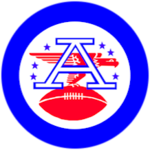| Most recent season or competition: 1969 American Football League season | |
 | |
| Sport | American football |
|---|---|
| Founded | 1959 |
| First season | 1960 |
| Ceased | 1970, merged with NFL as (AFC) |
| No. of teams | 8 (1960–1965), 9 (1966–1967), 10 (1968–1970) |
| Country | United States |
| Last champion(s) | Kansas City Chiefs |
| Most titles | Dallas Texans/Kansas City Chiefs (3) |
The American Football League (AFL) was a major professional American football league that operated for ten seasons from 1960 until 1970, when it merged with the older National Football League (NFL), and became the American Football Conference. The upstart AFL operated in direct competition with the more established NFL throughout its existence. It was more successful than earlier rivals to the NFL with the same name, the 1926, 1936 and 1940 leagues, and the later All-America Football Conference (which existed between 1944 and 1950 but only played between 1946 and 1949).
This fourth version of the AFL was the most successful, created by a number of owners who had been refused NFL expansion franchises or had minor shares of NFL franchises. The AFL's original lineup consisted of an Eastern division of the New York Titans, Boston Patriots, Buffalo Bills, and the Houston Oilers, and a Western division of the Los Angeles Chargers, Denver Broncos, Oakland Raiders, and Dallas Texans. The league first gained attention by signing 75% of the NFL's first-round draft choices in 1960, including Houston's successful signing of college star and Heisman Trophy winner Billy Cannon.
While the first years of the AFL saw uneven competition and low attendance, the league was buttressed by a generous television contract with the American Broadcasting Company (ABC), followed by a contract with the competing National Broadcasting Company (NBC) for games starting with the 1965 season, that broadcast the more offense-oriented football league nationwide. Continuing to attract top talent from colleges and the NFL by the mid-1960s, as well as successful franchise shifts of the Chargers from L.A. south to San Diego and the Texans north to Kansas City (becoming the Kansas City Chiefs), the AFL established a dedicated following. The transformation of the struggling Titans into the New York Jets under new ownership, including the signing of University of Alabama star quarterback Joe Namath, further solidified the league's reputation among the major media.
As fierce competition made player salaries skyrocket in both leagues, especially after a series of "raids", the leagues agreed to a merger in 1966. Among the conditions were a common draft and a championship game played between the two league champions first played in early 1967, which would eventually become known as the Super Bowl.
The AFL and NFL operated as separate leagues until 1970, with separate regular season and playoff schedules except for the championship game. NFL Commissioner Pete Rozelle also became chief executive of the AFL from July 26, 1966, through the completion of the merger.[1] During this time the AFL expanded, adding the Miami Dolphins and Cincinnati Bengals. After losses by the Kansas City Chiefs and Oakland Raiders in the first two AFL-NFL World Championship Games to the Green Bay Packers (1966–67), the New York Jets and Chiefs won Super Bowls III and IV (1968–69) respectively, cementing the league's claim to being an equal to the NFL.
In 1970, the AFL was absorbed into the NFL. The ten AFL franchises joined three existing NFL teams- the Baltimore Colts, the Cleveland Browns, and the Pittsburgh Steelers-to form the merged league's American Football Conference.
- ^ Milligan, Lloyd (26 July 1966). "New Pact to Last at Least 3 Years: Woodard's Position Unsure After 1970 Merger" (PDF). The New York Times. Archived (PDF) from the original on 2022-10-09. Retrieved 25 April 2018.